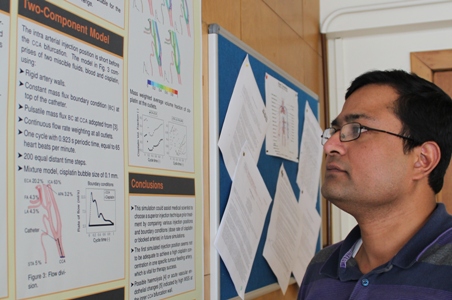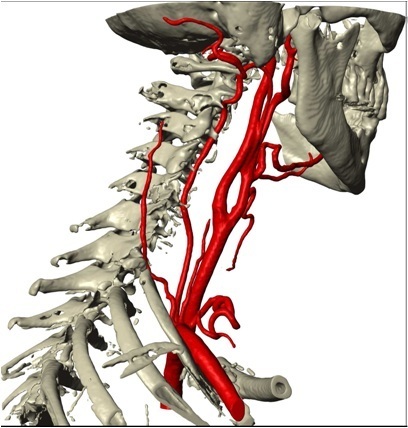Improved treatment for head & neck cancers could soon be on its way, say researchers
Published: 7 May 2012
Engineers and scientists are developing a new method of treating head and neck cancers they believe will make therapy more targeted and effective.
Engineers and scientists at the University of Glasgow are developing a new method of treating head and neck cancers they believe will make therapy more targeted and effective.
Cancer kills over 150,000 people in the UK every year and oral/head and neck cancer (HNC) is in the top ten worldwide, with major risk factors being tobacco and alcohol consumption.
Surgery and radiotherapy are the principal treatment options for HNC, with chemotherapy also used, though not recommended as a sole treatment due to its toxicity and very low probability of cure. Usually, chemotherapy is combined with radiotherapy and is administered intravenously through a ‘drip’ in the arm but in this way, the chemotherapy drugs are spread throughout a patient’s whole body.
 The researchers within the Computational Fluid Dynamics (CFD) Group in the School of Engineering, in collaboration with Mr Duncan F Campbell, an Oral & Maxillofacial Surgeon in St John’s Hospital, NHS Lothian, have been working to develop a new way of using intra-arterial delivery which would concentrate chemotherapy drugs in the area around the tumour with lower doses for the organs vulnerable to toxicity. It is hoped this method would result in higher cure rates and fewer side-effects.
The researchers within the Computational Fluid Dynamics (CFD) Group in the School of Engineering, in collaboration with Mr Duncan F Campbell, an Oral & Maxillofacial Surgeon in St John’s Hospital, NHS Lothian, have been working to develop a new way of using intra-arterial delivery which would concentrate chemotherapy drugs in the area around the tumour with lower doses for the organs vulnerable to toxicity. It is hoped this method would result in higher cure rates and fewer side-effects.
Mr Campbell said: “Chemotherapy is ideally given at a high dose, but results in significant toxicity, for example neutropaenia/immunosuppression resulting from chemotherapy risks fatal pneumonia, renal failure and other morbidities.
“The ideal dose for each patient is not known so best guess doses are used and toxicity monitored, but some patients cannot tolerate this preferred dose.
“HNC cancer surgeons in the NHS are interested in the delivery of chemotherapy by intra-arterial methods particularly if we could map and control the dose gradients in different parts of the body.
“International studies have shown less toxicity with the intra-arterial route but this technique hasn’t caught on perhaps because the pharmacodynamics, flow gradients and individual variation between cancers and between patients is inadequately appreciated.
 “We’re working on these issues by modelling blood flow in the tumour area which is an important step in customising this treatment to give the each cancer the biggest chemo hit while reducing the toxicity for the vulnerable organs that we need to remain healthy. We will have to show that this extra effort is ‘worth the bother’ in clinical time and overheads before it will become mainstream.”
“We’re working on these issues by modelling blood flow in the tumour area which is an important step in customising this treatment to give the each cancer the biggest chemo hit while reducing the toxicity for the vulnerable organs that we need to remain healthy. We will have to show that this extra effort is ‘worth the bother’ in clinical time and overheads before it will become mainstream.”
The group is not yet ready to propose clinical trials which are at least a year from now.
The Flow Modelling research team led by Dr Manosh Paul at the University used computed tomography (CT) scans of patients and applied computational fluid dynamics techniques to model the distribution and concentration of a chemotherapeutic agent in the complex network of head and neck arteries surrounding a tumour.
This work runs in parallel with lab studies, led by Dr Paul Shiels at the University, of the same patients’ cancer cells to determine the dose needed for each patient. The CFD modelling then prescribes the ideally delivery method to achieve each patients cancer kill dose.
By taking into account many parameters, such as the location of injection, the pressure applied in injecting the fluid, the speed of blood flow and pulse rate, the researchers can find the right way of injecting the therapeutic agent that will concentrate it at the desired location.
Dr Manosh Paul said: “In inter-arterial infusion treatment, the chemotherapy dose is given to a specific artery feeding a tumour.
“Importantly, the knowledge about the chemical agent concentration in blood and the technique by which the tumours are infused are vital for a therapy success.
“Using computational fluid dynamics we investigate the effects of changes in various flow related and surgically relevant parameters to optimise the cancer dose locally at the cancer region.”
He added: “It would be also interesting to compare effectiveness of the cancer cure between the modelled intra-arterial (IA) and intra-venous (IV) treatment methods when the same dose is delivered.”
Mr Campbell said: “Surgical excision for HNC commonly leads to unilateral removal of major neck veins of patients, the implications of this are not understood. CFD models developed from a patient’s pre- and post-surgery CT scans would allow us to investigate this which might be relevant for subsequent metastases.”
Both believe that this new CFD-aided treatment method could have a significant impact on HNC cure rates, early detection and quality of life for patients incurable by conventional means, and potentially be useful to cure other cancers.
Dr Manosh Paul said: “If we can prove in the lab, and through computer modelling, that a highly customised approach is likely to be more effective then we will proceed to trials.”
The team is now working on major research proposals to secure external funding from MRC and the Wellcome Trust to the development of their innovative CFD-aided technology for potential clinical use in future.
For more information contact Stuart Forsyth in the University of Glasgow Media Relations Office on 0141 330 4831 or email stuart.forsyth@glasgow.ac.uk
First published: 7 May 2012
<< May

